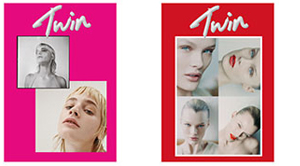From the 12th September to the 20th October, Amar Gallery in London will host Lina Iris Viktor’s first solo exhibition in the UK. Of British and Liberian heritage, Viktor explores narratives surrounding race and the African diaspora in her work.
Black Exodus brings together both new and existing abstract works, which have been made using Viktor’s trademark black and gold colour palette. This exhibition marks the first ‘Act’ in an evolving series for the artist, which reimagines artistic and socio-political definitions of blackness. Twin spoke to Viktor about the implications of her two-tone colour palate, and the exhibition’s roots in a mythologised dystopia where the black race no longer exists.
Black Exodus is based on a mythologised dystopia, where the black race has been extinguished. How do these works respond to that theoretical future?
These works are not literal interpretations of this theoretical concept, but rather investigatory visualisations that are very abstracted; the entire idea is completely abstract, though it may bare historical significance and relevance. My work has always been driven by concept. Whether or not I have chosen to clearly express the driving force, the conceptual narrative is central to the development of a body of work. On this occasion, I believed the concept was imperative to share when reading the work. However, these concepts are and never should be constricting.
All of my work is essentially a continual experiment – with concept, colour, and material stripping away all that is nonessential. The idea of a dystopic world where the black race no longer exists was conceived to illustrate how integral and essential the black race has and will always be to the development of humanity. It is more of an idea to keep in mind while viewing the work rather than a signifier that is sought through the work. The black in the work and the surrounding space is allegorical – as are all the hues, resonances, and finishes of black that are incorporated. Black is source: without it we all would cease to exist (as would light), so even theoretically it is an impossibility. But it is an interesting future to contemplate – especially with all that continues to be done to stymie the progress of those that belong to the African diaspora globally. It is our daily reality. I simply pose the question of a future without the black race, for the viewers’ contemplation rather than mine. I hope the works can further elaborate that question.
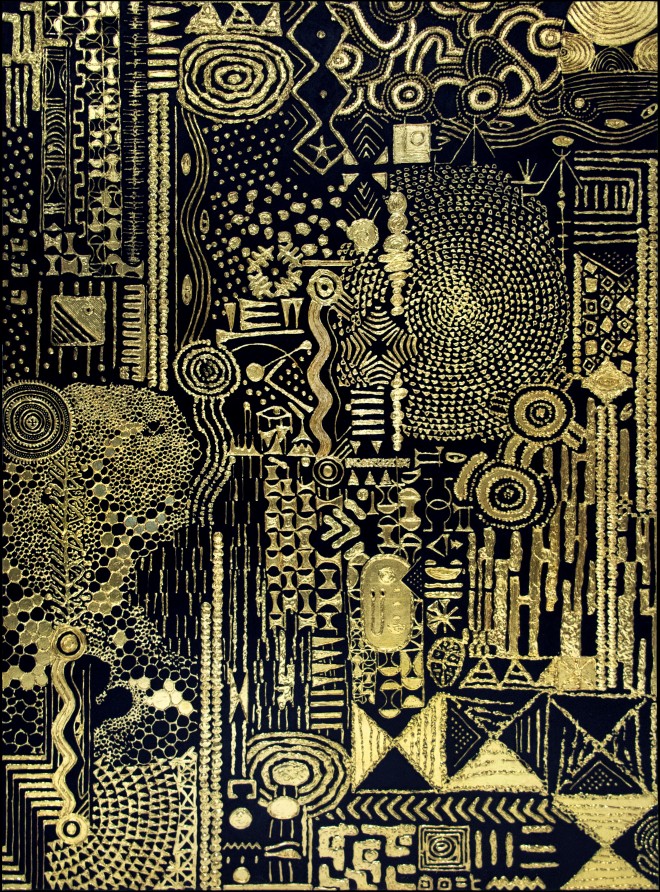
Lina Iris Viktor, Constellations III, Pure 24 Karat Gold, Acrylic, Gouache, Print on Matte Canvas 2016, Unique, courtesy the artist and Amar Gallery, London
Your colour palette for Black Exodus exclusively uses black and gold. What are the associations of those colours for you?
These are mainstays in my artist palette, which has always been very specific and focused. The departure into an entire body of works within this even more restricted palette was about stripping away all of the nonessential, and also seeing how far I could stretch and push these contrasting extremes into a series of unified works within a unified space. In my practice, black is a value – one polar extreme of the colour spectrum; it represents the full absorption of light within the colour spectrum and it contains all colours. Therefore it is completely saturated and colour-full. Gold is the closest to a godly metal one can find. Revered since its discovery, previous civilizations have likened it to the sun – a bearer of light – the immortal metal that will never tarnish, fade, or rust. Both black and gold hold light in very different frequencies and resonances; gold shines in the dark and requires very low-lit conditions to illuminate. In this exhibition, the gold imbued in light depicts the interconnectedness and interdependency of light to dark and vice versa. Both are required to appreciate the other.
This exhibition marks the first Act in an evolving series for you. How do you see the series developing?
I am already planning Act II for next year, and it will take the form of next solo show in New York. I grew up acting and in theatre, and I view each solo exhibition as a continuum, an intervention or revolt that is staged to counter what we have all been taught. This Act is called ‘Materia Prima’, meaning ‘first matter’, so it deals with the concepts expressed on a universal and primitive level through abstraction and limited palette. It addresses the relationship of light to dark, absence and presence et al. The next act will be an evolution from that, and it will be more topical and less abstracted. Essentially it will be the next chapter in my exodus story.
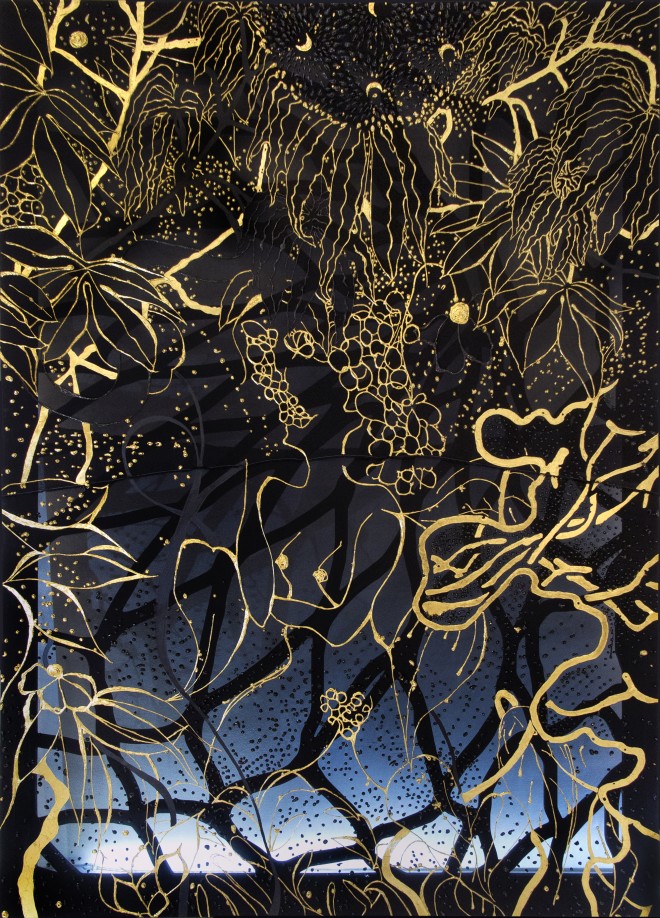
Lina Iris Viktor, Black Union Pure 24 Karat Gold, Acrylic, Charcoal, Poly Resin, Wood on Fabric 2017. Unique, courtesy the artist and Amar Gallery, London
How does this body of work depart from your previous collections?
I feel like all of my work is just a continued conversation that builds on the previous – each one poses more questions, and pushes me further technically and conceptually. But really, every artist only has a few good ideas that they delve deeper and deeper into over time. No matter how varied the work may appear, I have found that the core thesis is usually very consistent; they are essentially the questions you have been asking since you were born that you have yet to resolve.
This work is more complete as it is a suite of paintings, and it utilizes different creative processes to produce each – many processes that were experimental and will most likely be refined over time. I have become more open to the experimental aspect of work production – creating with less of a determined outcome.
Can you tell me a little bit about your artistic process?
A great deal of thinking and planning before execution. The execution happens quickly, but the preparation can take an age.
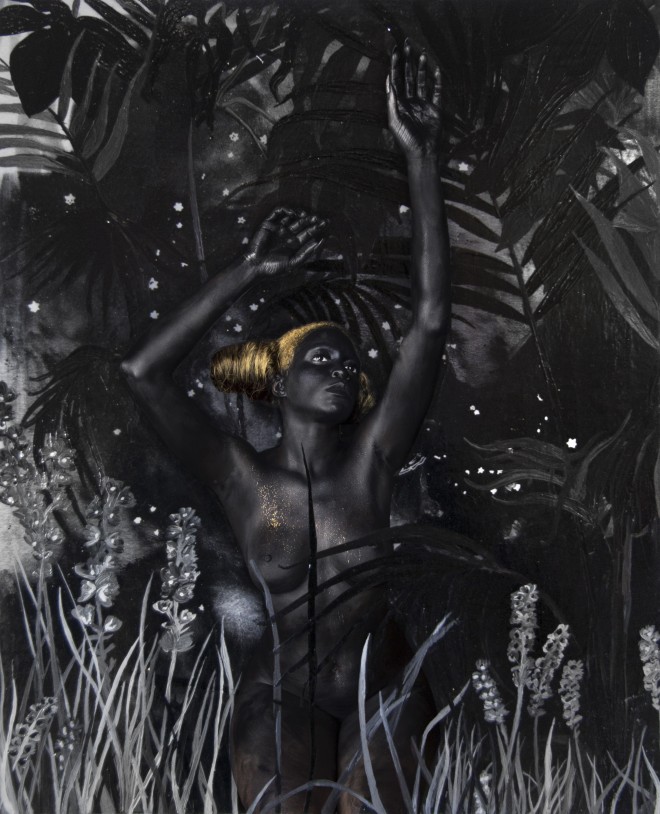
Lina Iris Viktor, Dark Continent No. XX _ A prophecy. And the scramble began . . . Acrylic, Ink, Print on Cotton Rag Paper _ 1 of 3 _ 2017, courtesy the artist and Amar Gallery, London
How does your work unite materials and methods from both contemporary and ancient art forms?
I gild with 24-karat gold, which is an ancient practice that I have modernized for my usage. I gild on a variety of substrates and materials that are not conventional within traditional gilding practices.
What do you hope people will take away from this exhibition?
I hope that it is somewhat of a visual assault, a slight overload for the senses in simple complexity. The works are very dense and the space is also limited, adding to the visual barrage. I want people to enjoy it on an aesthetic level, as well as really contemplate this theoretical concept when viewing the work. I just want them to hold that idea in their head and think about the implications. I believe anyone open enough to view my work will also be open enough to ponder this fictional dystopia. The space will be built to be one of contemplation – a black & gold chapel of sorts.
Lina Iris Viktor’s first solo UK show, Black Exodus: Act I, will be on display at the Amar Gallery in London from September 12 to October 20 amargallery.com

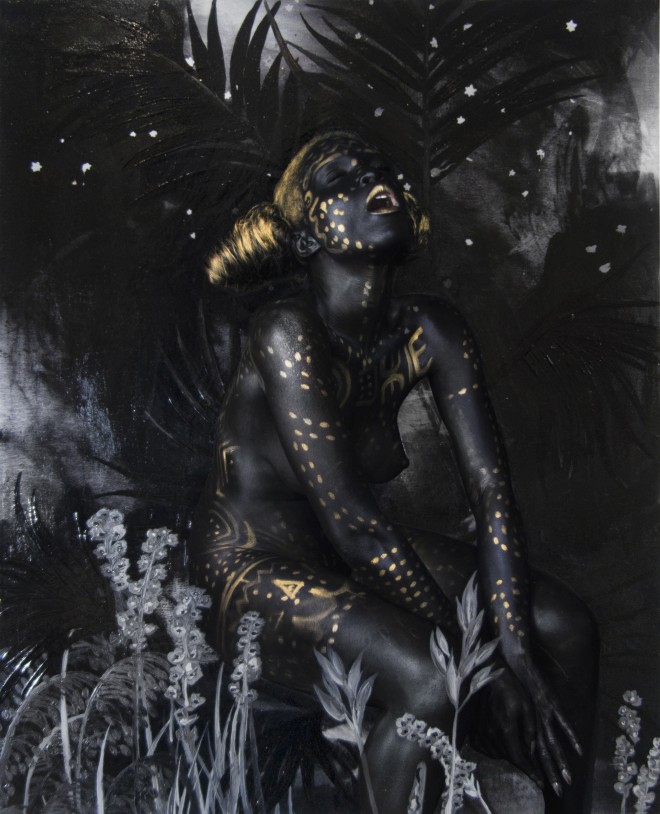
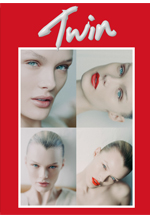
 Twitter
Twitter
 Tumblr
Tumblr
 YouTube
YouTube
 Facebook
Facebook
 Instagram
Instagram
